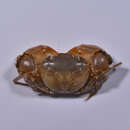pms
nòm ant ël fil


Eucrate crenata, the blunt-spined euryplacid crab, is a species of Indo-Pacific crab from the family Euryplacidae. It has invaded the Mediterranean Sea from the Red Sea by Lessepsian migration through the Suez Canal.
Eucrate crenata has a cream coloured, purple speckled carapace. The carapace is smooth and trapezoid shaped being slightly wider at the front than at the posterior. Anterolateral margins are shaped into four teeth, including the orbital angle, with the second and fourth tooth being barely distinguishable. The claws are unequal in size and less than twice the length of the carapace, the walking legs are relatively long, smooth but with hairy tufts on the three outer joints while the last pair of walking legs is flattened. In many specimens there is a medium-sized red spot on the dorsal part of branchial region of the carapace, and also on the subhepatic region on the ventral surface of the carapace. The maximum length of the carapace is 35mm.[2][3][4]
Eucrate crenata has a natural range from the Red Sea east to the Hawaii.[1] It was first recorded in the Mediterranean Sea off Alexandria in the mid 1930s, and has since spread north to Haifa in Israel, to Turkey and west to the Gulf of Gabes in Tunisia.[2] It is one of the commoner crustaceans found in the Suez Canal.[5]
Eucrate crenata occurs in areas sand or sandy mud substrates and in areas covered with the sea weed Caulerpa at depths of 35 to 100 meters.[3][4] In the Bohai Sea off China E.crenata is one of the principal prey items for the tonguefish Cynoglossus semilaevis.[6]
Eucrate crenata, the blunt-spined euryplacid crab, is a species of Indo-Pacific crab from the family Euryplacidae. It has invaded the Mediterranean Sea from the Red Sea by Lessepsian migration through the Suez Canal.
Eucrate crenata (De Haan, 1835) è un granchio della famiglia Euryplacidae[1].
Ha un carapace quadrangolare, più largo che lungo, circa 35 mm, di colore crema finemente punteggiato di porpora, con due macchie scure ben distinte nella regione epatica, dotato di chelipedi robusti e leggermente diseguali.[2]
La specie è ampiamente distribuita nell'Indo-Pacifico, dal mar Rosso alle isole Hawaii. Si è introdotta nel mar Mediterraneo attraverso il canale di Suez (migrazione lessepsiana) ed è stata segnalato in Egitto, Turchia, Israele e Tunisia.[3]
Eucrate crenata (De Haan, 1835) è un granchio della famiglia Euryplacidae.
Eucrate crenata is een krabbensoort uit de familie van de Euryplacidae.[1] De wetenschappelijke naam van de soort is voor het eerst geldig gepubliceerd in 1835 door De Haan.
Bronnen, noten en/of referenties隆线强蟹(学名:Eucrate crenata)为长脚蟹科强蟹属的动物。分布于朝鲜海峡、日本、泰国、印度、红海以及中国大陆的广东、福建、山东、渤海等地,生活环境为海水,一般栖息于水深30-100米的泥沙质海底上。其生存的海拔范围为-100至-30米。[1]
隆线强蟹(学名:Eucrate crenata)为长脚蟹科强蟹属的动物。分布于朝鲜海峡、日本、泰国、印度、红海以及中国大陆的广东、福建、山东、渤海等地,生活环境为海水,一般栖息于水深30-100米的泥沙质海底上。其生存的海拔范围为-100至-30米。